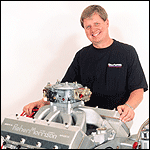 By David Reher, Reher-Morrison Racing Engines
By David Reher, Reher-Morrison Racing Engines
A strong, dependable block is the cornerstone of every racing engine. It’s the foundation that supports all of your efforts to build horsepower. Yet as important as the block is in building a reliable and powerful motor, too many racers still insist on using a “good old block” as the starting point for a competition engine. In my opinion, that’s a major mistake. The truth is that there aren’t any good old blocks – at least when the subject is big-block Chevrolet V8s.
The big-block Chevy and its derivatives have become dominant in sportsman drag racing. There are armies of Rat motors marching through the staging lanes in the heads-up Super eliminators, Quick 32 and fast bracket categories. It’s amazing that an engine that debuted 38 years ago is the powerplant of choice in our sport, but it’s tough to beat the big-block’s combination of performance, reliability, and affordability.
While the technology of drag racing has changed dramatically since the big-block Chevy was introduced in 1965, some racers remain stuck in the past. They still believe that an original 4.250-inch bore factory block is the ideal starting point for a big-block racing engine. Unfortunately, they’re wrong – and that costs them time, money, and horsepower.
The fact is that aftermarket blocks from Dart and World and GM’s heavy-duty Bow Tie blocks are vastly superior to the original production castings. They’ve got siamesed cylinder barrels that allow larger bore diameters (up to 4.600 inches), stronger main bearing webs, thicker deck surfaces and improved oiling systems. It’s simply throwing good money after bad to invest in a decades-old production block for racing when these modern alternatives are available.
The chief shortcoming of a production Chevy big-block is its limited bore diameter. The big-block’s 4.250-inch cylinder bore diameter is a compromise even with stock heads – that’s why the factory notched the tops of the cylinder bores for intake valve clearance in high-performance engines. Chevy engineers may have been concerned about the long-term reliability of siamesed cylinder bores when the big-block was designed. We know now, however, that siamesed bores work just fine in everything from street engines to Winston Cup and Pro Stock motors. Eliminating the water passages between adjacent cylinders is the key that opens the door to building big-inch big-blocks.
Increasing cylinder bore diameter improves engine performance in many ways. Within reasonable limits, a bigger bore is like getting free cubic inches. By that I mean that big-bore pistons aren’t significantly more expensive than comparable small-bore pistons. The piston speed is the same regardless of piston diameter, and you don’t invite the potential oiling problems and windage losses that come with long-stroke cranks. Most importantly, a large cylinder bore complements the big-block Chevy’s combustion chamber design and valve spacing.
It’s actually more expensive to build a large displacement engine with a “good old block” than it is to build an even bigger engine with a modern block. If you start with a 4.250-inch bore block, you’ll spend big bucks on a 4.250-inch stroke crankshaft to end up with 496 cubic inches. It’s a much better deal to buy a new block that can be bored to 4.600-inch diameter and use a readily available 4.00-inch stroke crank. This combination gives you 530 cubic inches, along with all of the performance benefits of a big-bore/short stroke engine.
Some racers insist that they can save money by reusing an old block, yet many of these same people won’t hesitate to buy new aluminum cylinder heads, intake manifolds and carburetors that cost much more than a new big-bore block. In reality, an aftermarket block is a bargain because it’s the structure that supports all of the other components. You’ll be able to realize the performance potential of competition heads, manifolds and camshafts much more easily with a big-bore block than with a production casting.
I still see magazine articles about using seasoned blocks. Well, I can’t think of a single valid reason to use any old block in racing today. Scouring junkyards for blocks was something we did years ago because there wasn’t anything else available. Now, however, the speed equipment industry has advanced to the point that you can get virtually anything you need – including state-of-the-art big-blocks.
Sinking money into a vintage block is like trying to make your old computer work with the latest software. It wouldn’t make sense to hop up an IBM 286 to run Windows XP software – not when you can buy a brand-new computer that’s less expensive and already designed to use sophisticated programs. Smart racers don’t use outdated computers, so why would they use antique engine blocks?
I’m not trying to push aftermarket blocks, but I am trying to help racers get the right parts. If you analyze the long-term costs and benefits, you’ll see that you can actually get more performance and reliability for less money with a modern big-bore block.
My advice is to sell that “good old block” to a car restorer and use the money to buy a contemporary casting. And if you just can’t bear to part with your cherished block, I suggest you use it as a coffee table.
